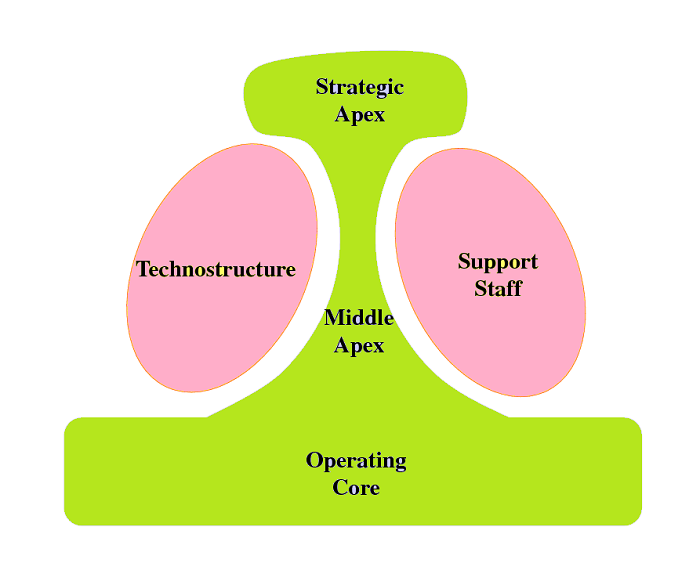Management expert Henry Mintzberg proposed that traditionally organizations (profit making or not for profit) can be divided into five components. In practice organizational structure may differ from proposed model. Factors influencing organizational structure are industry norms, size, experience, culture, external forces (competition, inflation, minimum wage legislation etc). Components identified by Mintzberg is useful for understanding the workflow of organizations.
The structure of an organization can be defined simply as the sum total of the ways in which it divides its labor into distinct tasks and then achieves coordination among them” – The Structuring of Organizations, Henry Mintzberg.
1. Strategic Apex
Strategic apex is the most senior level in the organization. Management working at this level is referred as board of Directors (chairman, CEO, executes and non executive directors). They set the objectives (increase sales by 10% in one year) and strategic direction (new product and markets developments) of the organization. They take major investing (takeovers) and financing (Shares issue) decisions. They are not involved in day to day operations of the business. They do not deal with customers and suppliers except in exceptional cases (dealing with complaints). They represent the organizational face to external stakeholders (person have interest in the organization like government). Integrity of organization can be judged by integrity of its board of directors.
2. Middle Line
Middle line managers interprets objectives and strategies of the strategic level management into feasible plans and standards to get the work done through operational managers. They set budget, receives reports from management accountants, monitors performances and take corrective actions where necessary. They often take investing (purchase an equipment) and financing (trade payable and overdraft management) decision to the extent of authority given by strategic level management. They synchronize works of individual departments so that all departments works in single direction towards the achievement of organizational objectives. Making 20000 units of a product by production department does not help achieve organizational objectives if sales department can not sell them.
3. Operational Core
Operational core manager often referred to as operational managers are involved in day to day running of the organizations. They are the personnel who actually achieves organizational objectives under the guidance of senior managers. They deals with external stakeholder (customers and suppliers etc). They are responsible for quality and efficiency of the organizational results. They provide important information in deciding strategic directions and budgeting by senior managers, as they now better what is practicable due their operational experience.
4. Technostructure
Personnel work in technostructure are employees and managers just in the same way as chain command runs from strategic apex to operational core. Difference is they do not involved in any revenue generating or core (for which organization exists) activity. They only assist managers at all levels performing core activities to perform it effectively and efficiently and report whenever corrective actions needs to be taken to achieve the performance targets and objectives. What activity or functional department is considered under technostructure depends on industry like in banking sector accounting is considered a core activity, while in supermarket accounting is optional activity because supermarket will not closedown if accountants get absent, they just provides information on inventory, debtors and creditors information.
5. Support Staff
Support staff is of least importance to the organization as their absence does not directly affects the performance of organization. Organization still spends on supporting activities because it provides good working environment and facilities (peon) to core employees to prevent down time. Departments like canteen, cleaning and maintenance comes under this heading. As like technostructure, what is considered supporting activities depends on the industry.
Based on the importance of the components, coordinating mechanisms and design decisions (design of decision making, lateral linkages, superstructure and positions), five structural configurations were established:
- Simple Structure: The major coordinating mechanism used here is direct supervision. The key component of the organization in this case would be the strategic apex, and vertical and horizontal centralization is incorporated in this configuration.
- Machine bureaucracy: The coordinating mechanism here is standardization of work processes. The key component of the organization here would be the technostructure and limited horizontal decentralization is used.
- Professional bureaucracy: Standardization of skills is the coordinating mechanism in this configuration. The operating core forms the key component and both vertical and horizontal decentralization is used.
- Divisionalized form: Standardization of outputs is the coordinating mechanism and the key component is the middle line. It is characterized by limited vertical decentralization.
- Adhocracy: Mutual adjustment is the coordinating mechanism in this configuration. The support staff (in an administrative adhocracy) or the operating core (in an operating adhocracy) forms the key component. Selective decentralization is used in this case.
